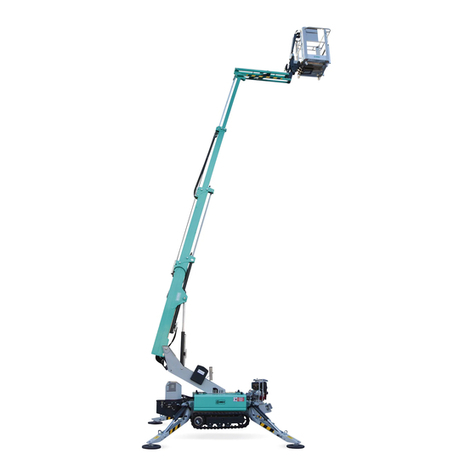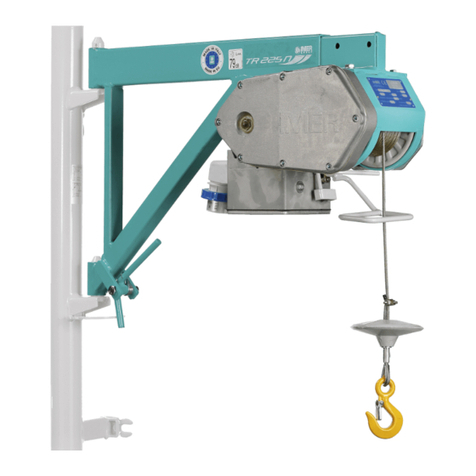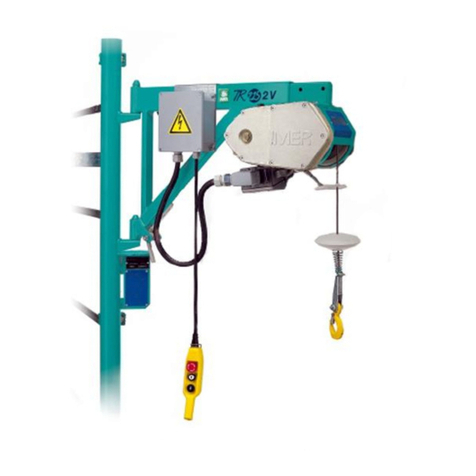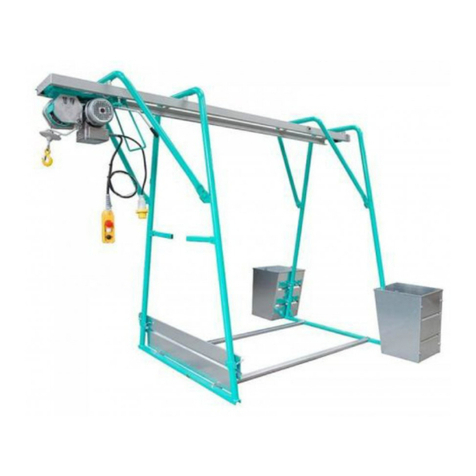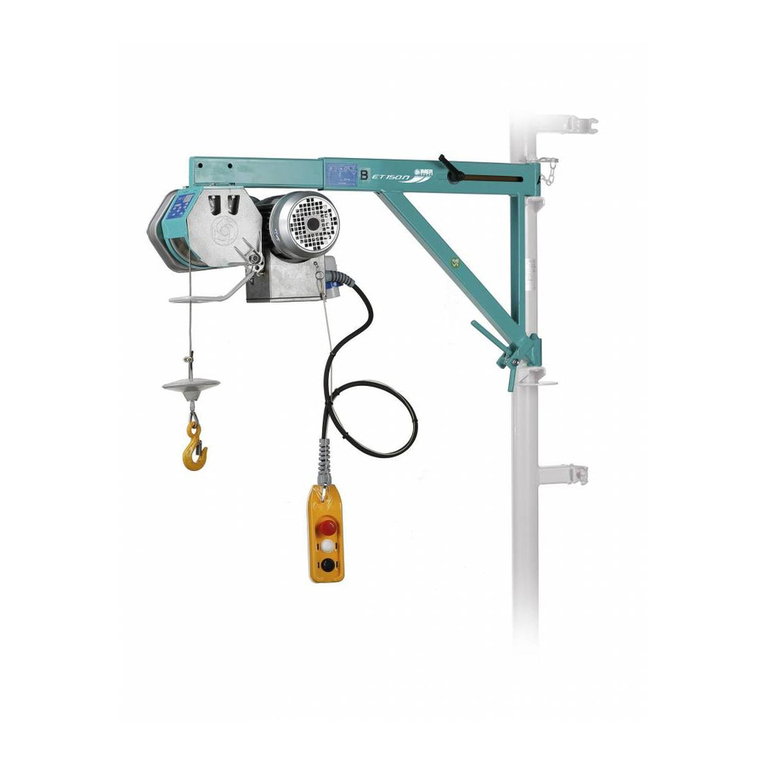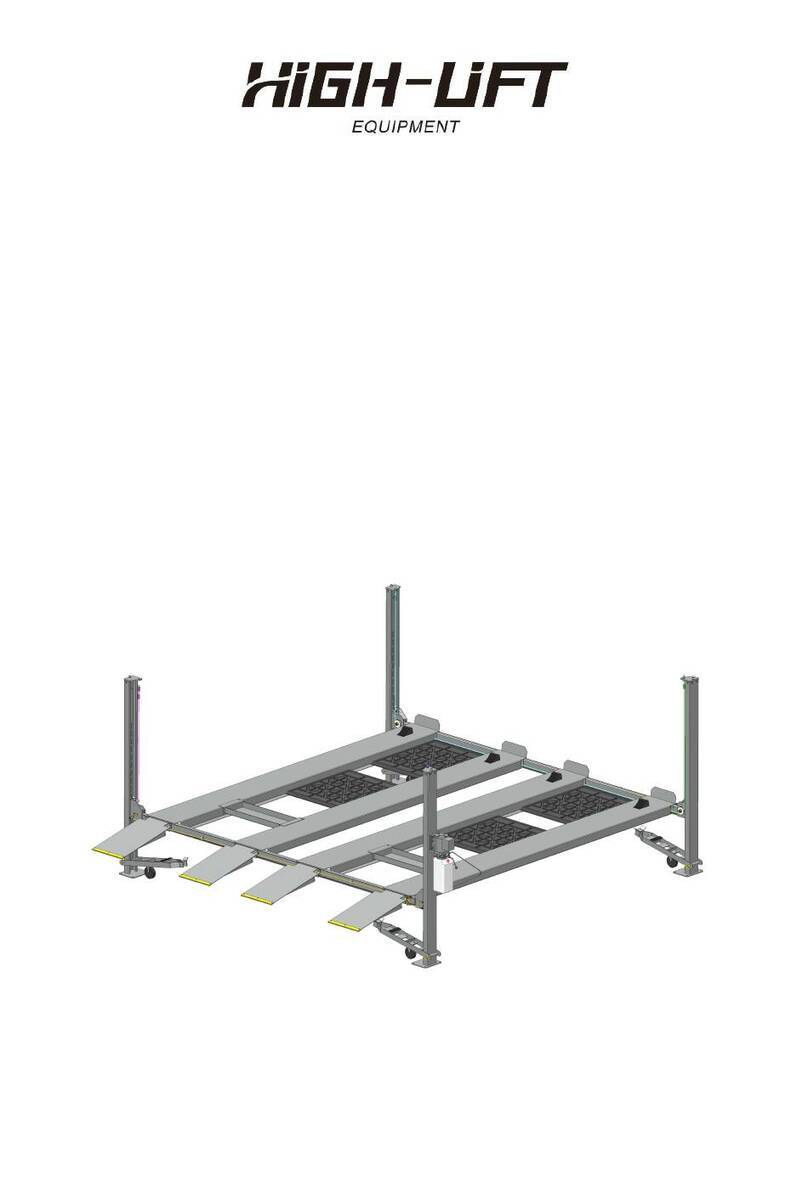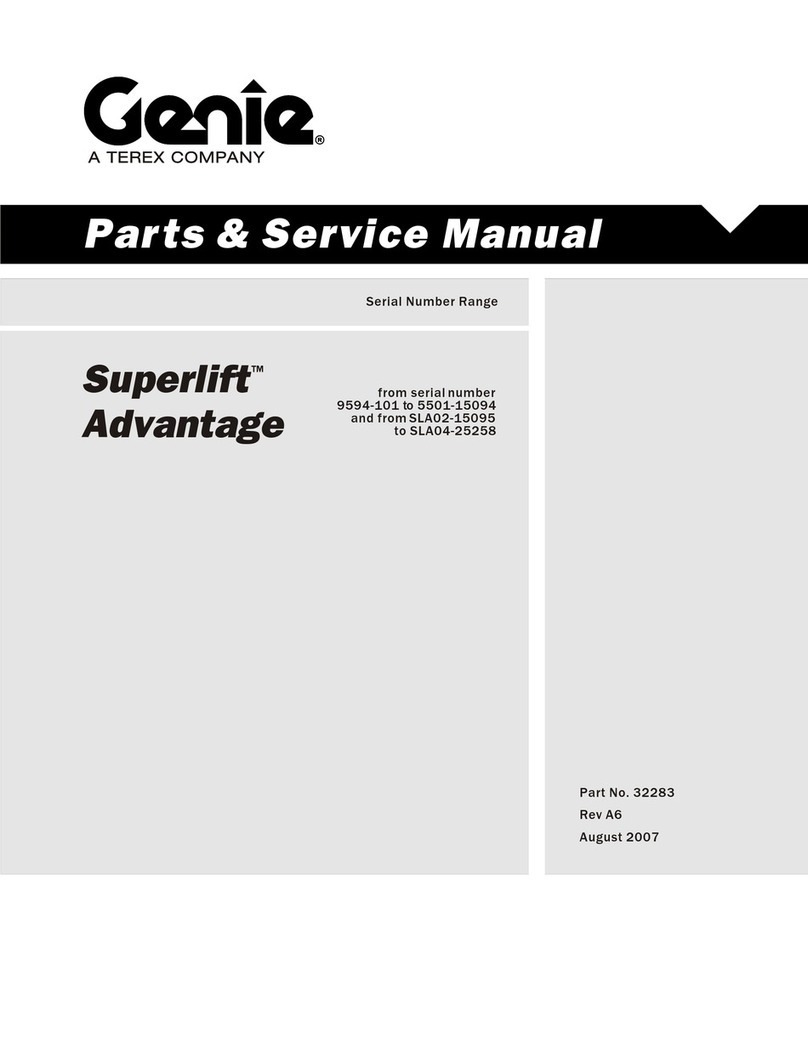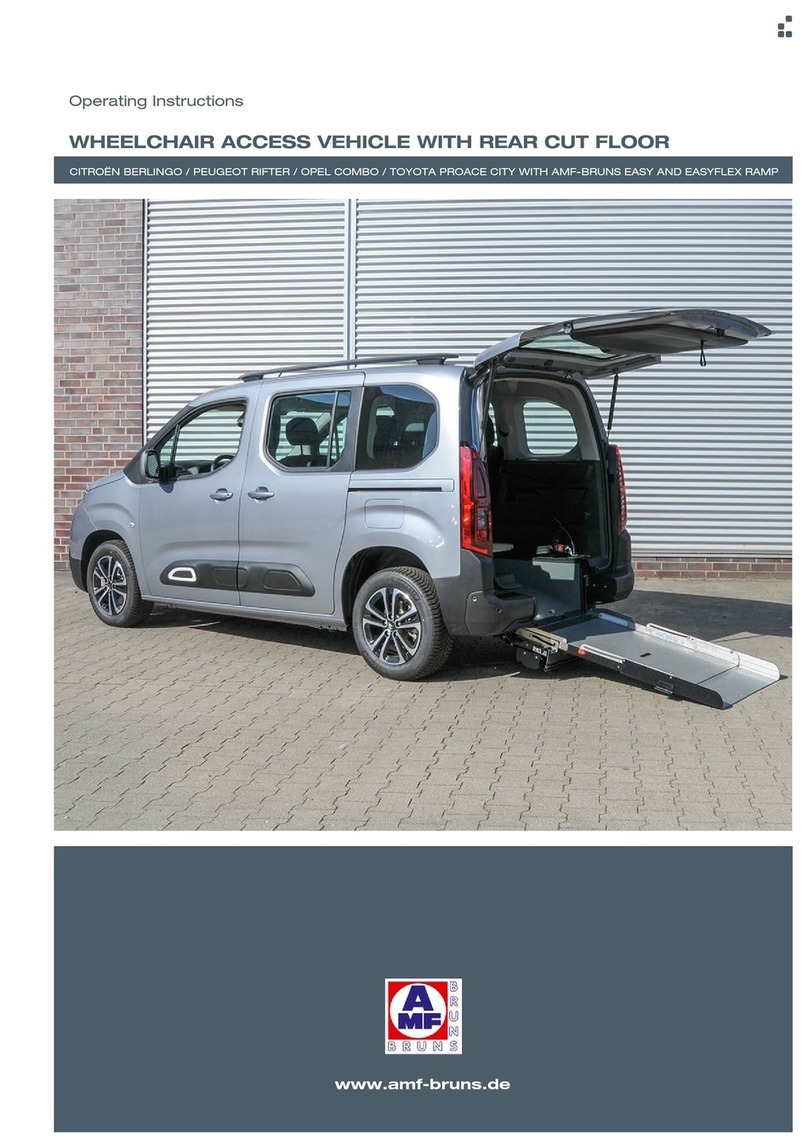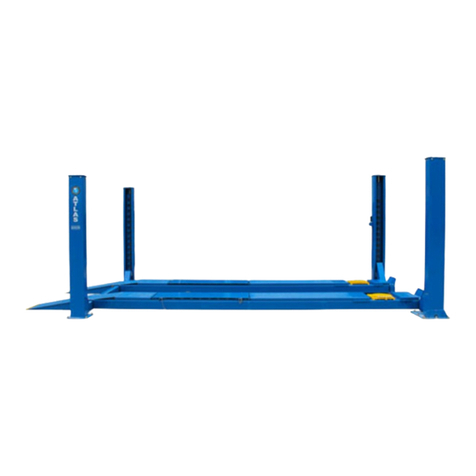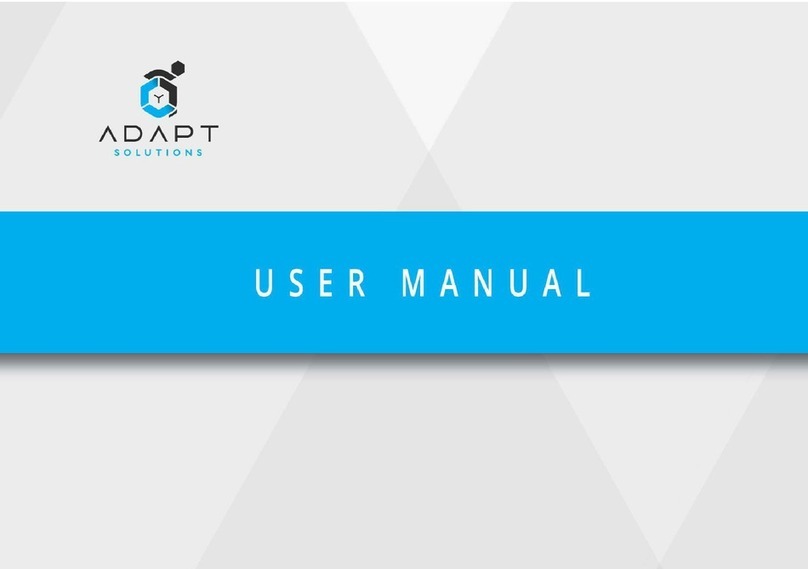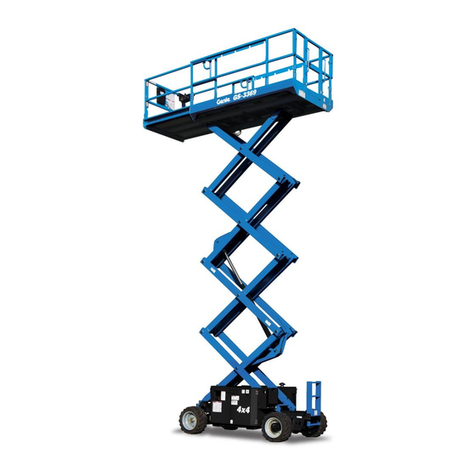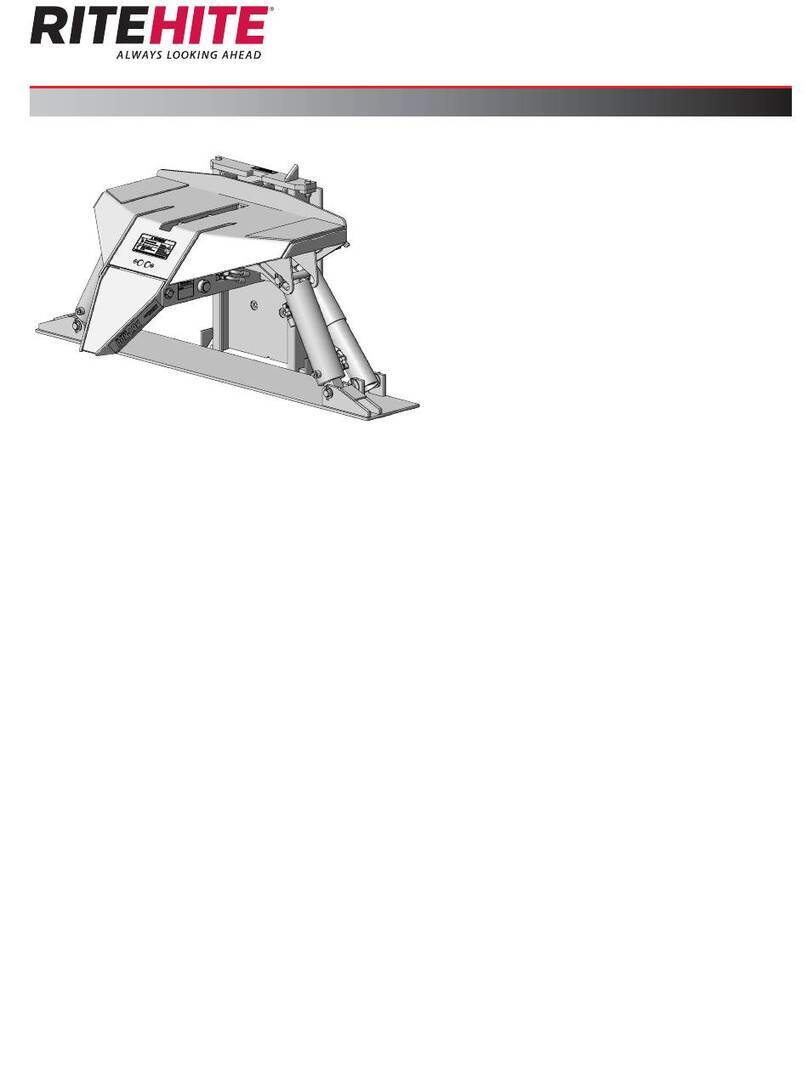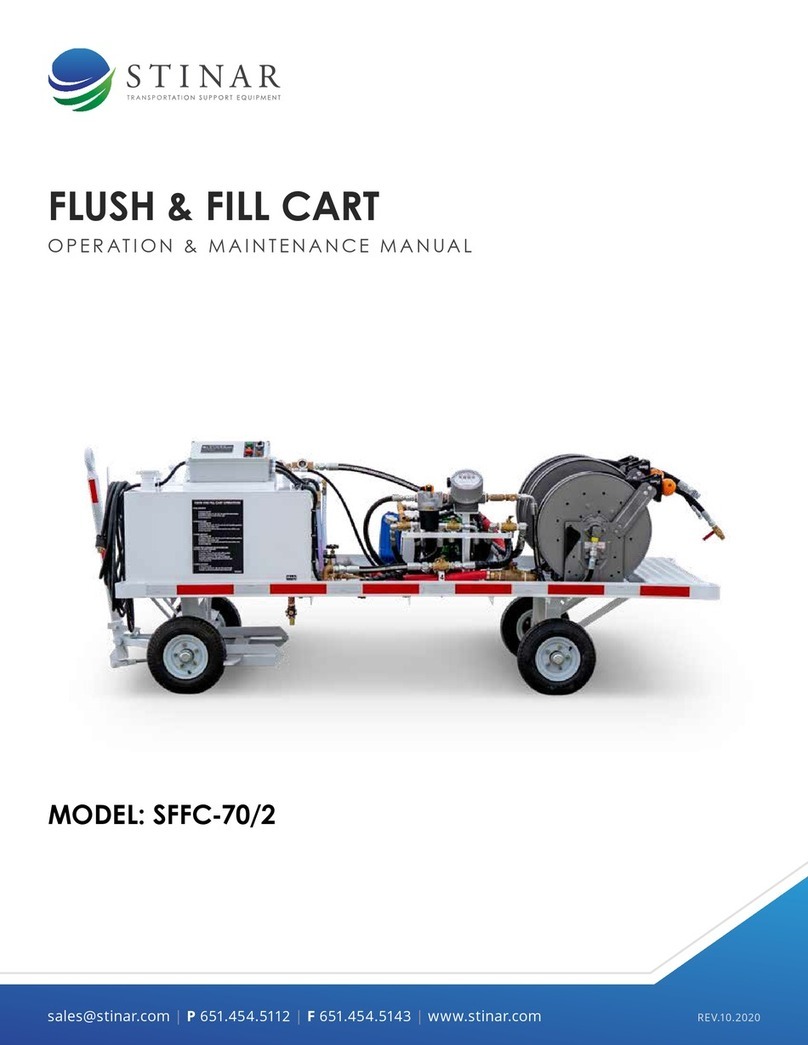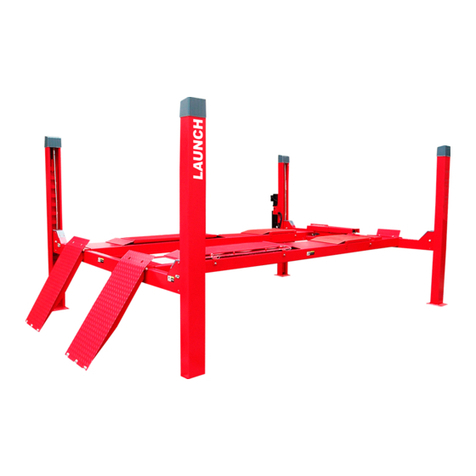IMER ET 300 Guide

R03 - 2004/01
- Cod. 3213668 -
IMER INTERNATIONAL S.p.A.
53036 POGGIBONSI (SIENA) loc. SALCETO
(ITALY)
Tel. +39.0577.973.41 - Fax. +39.0577.983.304
ELEVATORE
HOIST
(1140955 - 110V / 50Hz)
Manuale uso manutenzione ricambi
Operating, maintenance, spare parts manual

IMER INTERNATIONAL S.p.A.
ET 300 (110 V/50 Hz)
-
-
2
Fig. 1
1
FUNE ACCIAIO
2
GANCIO
3
TAMBURO
4
MOTORE ELETTRICO AUTOFRENENTE
5
QUADRO ELETTRICO
6
TELAIO
7
RUOTINA
8
FRENO DI STAZIONAMENTO
9
LEVA FINECORSA SUPERIORE
10
CONTRAPPESO
11
RIDUTTORE
12
PULSANTIERA
13
SPINA VOLANTE
1
ROPE
2
HOOK
3
DRUM
4
ELECTRIC BRAKE MOTOR
5
ELECTRIC PANEL
6
FRAME
7
WHEEL
8
HAND BRAKE
9
UP LIMIT SWITCH LEVER
10
COUNTERWEGHT
11
GEAR BOX
12
PENDANT CONTROL
13
FLYING SOCKET
Particolare attenzione deve essere fatta alle avvertenze contrassegnate con questo simbolo :
Special attention must be given to warnings with this symbol:
DATI TECNICI
TECHNICAL DATA
Portata max
Max capacity
kg
300
Velocità media di sollevamento Lifting speed m / 1'
19
Altezza max di lavoro Max working height m
25
Alimentazione Nom. voltage
V / Hz
110 / 50
Potenza motore
Motor power
Kw
1,1
Giri motore
R.P.M.
n° / 1'
1300
Assorbimento Nom. current A
25
Tipo di servizio Service type
S3
50 %
Livello di emissione sonora -- LwA
(EN ISO 3744)
Level of noise emission -- LwA
(EN ISO 3744)
dB
89
Livello di pressione sonora -- LpA -- 1,5 mLevel of noise pressure -- LpA --
1,5m
dB
<75
Peso della macchina Hoist weight
kg
50
Ingombro per l'imballo Packing dimensions
mm
820x350x420
Norme di progetto Design standards
DPR 459
del 24.7.96
S.IN°3073 of 30/11/92
FEM 1.001 UNI-ISO 4301-4308-2408 UNI7670-9466 EN 60204-1
380
1
9
780
2
3
4
5
67
8
10
11
12
330
260
13

IMER INTERNATIONAL S.p.A.
ET 300 (110 V/50 Hz)
-
-
3
I
Caro cliente, ci complimentiamo per il suo acquisto dell argano IMER,
risultato di anni di esperienza: è una macchina di massima affidabilità e
dotata di soluzioni tecniche innovative.
OPERARE IN SICUREZZA: É fondamentale ai fini della si-
curezza leggere attentamente le seguenti istruzioni.
Il presente manuale di USO E MANUTENZIONE deve essere custodito
dal responsabile di cantiere, sempre disponibile per la consultazione.
Il manuale è da considerarsi parte della macchina e deve essere conser-
vato per futuri riferimenti (EN 292/2) fino alla distruzione della macchina
stessa. In caso di danneggiamento o smarrimento potrà essere richiesto
al costruttore un nuovo esemplare.
Il manuale contiene importanti indicazioni sulla preparazione del cantie-
re, l installazione, l uso, le modalità di manutenzione e la richiesta di parti
di ricambio.
Comunque è da ritenersi indispensabile una adeguata esperienza e co-
noscenza della macchina da parte del montatore e dell utilizzatore.
Affinché sia possibile garantire lasicurezza dell operatore, la sicurezza di
funzionamento e una lunga durata dell apparecchio, devono essere ri-
spettate le istruzioni del manuale, unitamente alle norme di sicurezza e
prevenzione degli infortuni sul lavoro secondo la legislazione vigente (uso
di calzature e abbigliamento adeguati, uso di elmetti, di cinture di sicurez-
za, predisposizione di parapetti prospicienti il vuoto, ecc.).
É vietato apportare modifiche di qualsiasi natura alla strut-
tura metallica o impiantistica della macchina e del caval-
letto.
IMER INTERNATIONAL declina ogni responsabilità in caso di non osser-
vanza delle leggi che regolano l uso di apparecchi di sollevamento, in
particolare: uso improprio, difetti di alimentazione, carenza di manuten-
zione, modifiche non autorizzate, manomissioni e/o danneggiamenti, inos-
servanza parziale o totale delle istruzioni contenute in questo manuale.
IMER INTERNATIONAL ha il diritto di modificare le caratte-
ristiche dell elevatore e/o i contenuti del presente manua-
le, senza l obbligo di aggiornare la macchina e/o i manuale
precedenti.
ATTENZIONE!
PER L ELEVATORE E OBBLIGATORIA LA
DENUNCIA ALLI.S.P.E.S.L. E LA VERIFICA PERIODICA A
NORMA DI LEGGE.
1. DESCRIZIONE GENERALE
Avvertenza: Operare con una macchina di sollevamento
richiede grande attenzione e perizia, il comando può esse-
re affidato solo a personale esperto o che abbia ricevuto le
necessarie istruzioni.
1) La macchina è concepita per il sollevamento di materiali
e per essere utilizzata nei cantieri di costruzioni edili.
2) É vietato l uso per il sollevamento di persone e/o di ani-
mali.
3) Non deve essere utilizzato in ambienti ove esista il peri-
colo d esplosioni o incendio o in ambienti di scavi sotter-
ranei.
La macchina è costituita essenzialmente da (fig.1):
- telaio (6) con il freno di stazionamento azionato manualmente (8).
- Tamburo (rif. 3) montato sull albero del riduttore (rif.11), da una fune
metallica (rif.1), da un gancio di sollevamento (rif.2) e contrappeso (rif.10).
- Motoriduttore composto da un motore elettrico autofrenante (rif.4) e
riduttore ad ingranaggi a bagno d olio (rif.11).
- Leva di comando fine corsa salita (rif. 9).
- Impianto elettrico (rif.5), pulsantiera a
comando diretto (rif.12) e spina volante
(rif. 13).
2. STRUTTURE DI SUPPORTO
IMER PER L ELEVATORE
Lastrutturasucuil elevatore viene appli-
cato deve essere in grado di sopportare
le sollecitazioni indicate in fig. 2, che si
generano durante il funzionamento.
La IMER costruisce il supporto a caval-
letto, rappresentato in fig. 7, apposita-
menteprevistoperlapplicazioneneican-
tieri edili e progettato in modo da trasmet-
tere idoneamente alle strutture di soste-
gno questi carichi.
ATTENZIONE.
La dichiarazione CE di conformità allegata al presente ma-
nuale, è valida solo se vengono
utilizzati tutti componenti
di costruzione IMER
(elevatore e cavalletto).
Se questa condizione non è rispettata, tale dichiarazione
vale solo per l' elevatore. Chi esegue l installazione dell'
elevatore su un altro tipo di cavalletto dovrà compilare una
nuova dichiarazione CE di conformità, dopo aver verifica-
to tutti i requisiti contenuti nella Direttiva Macchine 89/392/
CEE e sue successive modifiche ed integrazioni.
Le forze, indicate agli appoggi del cavalletto, dovranno essere considera-
te nel calcolo di verifica delle strutture di sostegno (ponteggi, terrazze,
soffitti, ecc.) effettuato da tecnico competente.
Nel caso si utilizzino dei supporti con portata diversa dall elevatore, sul-
l insieme dell apparecchio installato dovrà essere affissa, ben visibile la
portata ammissibile in funzione dell elemento più critico del sistema.
2.1 PREDISPOSIZIONE DEL POSTO DI LAVORO
Il lato dell apertura di accesso del carico al piano deve es-
sere protetto con un parapetto di altezza superiore a 1m
ed arresto al piede.
-Accertarsi che la corsa di lavoro sia sgombra per tutta laltezza e pren-
dere le precauzioni necessarie perché nessuno possa sporgersi dai piani
intermedi.
- Delimitare larea di carico inferiore perché nessuno possa sostarvi du-
rante il sollevamento.
3. MONTAGGIO (fig.1)
Il montaggio dell elevatore, così come il suo utilizzo, richiede personale
esperto o che abbia ricevuto le necessarie istruzioni.
Dato il peso dell elevatore, devono essere impiegati un numero di opera-
tori tali da non creare situazioni di pericolo durante il suo trasporto ed
installazione.
Laltezza massima di lavoro (25m) è quella relativa alla posizione del
motoriduttore corrispondente alle guide del cavalletto in cui si inseriscono
le ruotine (rif. 7) dell elevatore.
Montarelelevatoresulsupportoa cavallettoinserendole ruote (rif.7fig.1)
nelle guide della longarina (fig. 7) sbloccando contemporaneamente il
frenodistazionamento(rif.8).Impedirel uscitadellelevatorefissando alla
longarina la squadra di battuta.Seguire il resto delle istruzioni riportate nel
par.7.
Tutti i dispositivi di comando sono
dotati di pulsantiera a 3 pulsanti
(fig. 3):
nero = discesa
bianco = salita
rosso=arrestoincasodemergen-
za.
Liberare il gancio.
4. ALLACCIAMENTO ALLA RETE ELETTRICA
- Verificare che la tensione risulti conforme ai dati di targa della macchina.
- Verificare inoltre che la tensione di linea sia compresa tra -5% e +5%
del valore nominale con l elevatore in funzione a pieno carico.
- La linea elettrica di alimentazione deve essere provvista sia di protezio-
ne contro le sovracorrenti, sia di tipo differenziale e che il conduttore di
collegamento a terra abbia una sezione come quella del conduttore. Il
dimensionamento dei conduttori deve tener conto delle correnti di funzio-
namento e della lunghezza della linea per evitare eccessive cadute di
tensione (rif. Tab.1).
Evitare limpiego di prolunghe avvolte a spire sui tamburi.
- Il conduttore di alimentazione deve essere di tipo adatto per frequenti
movimenti e rivestimento resistente alla abrasione (per esempio H07RN-
F).
- Collegare la spina alla macchina ad una presa CEE da 32 Ampere con
grado di protezione IP67, avvitando la ghiera di ritegno meccanico.
- Lelevatore è così pronto per la prima manovra di collaudo.
I
Fig. 2
Fig. 3

IMER INTERNATIONAL S.p.A.
ET 300 (110 V/50 Hz)
-
-
4
I
5. ISTRUZIONI DI COLLAUDO
Attenzione! Questa prova deve essere eseguita da perso-
nale esperto e competente e devono essere prese le ne-
cessarie precauzioni per la sicurezza del personale.
Attenzione: ilcollaudo deve essere eseguitoprima dell uti-
lizzo dell elevatore.
Prima di iniziare il collaudo verificare accuratamente che
tutta l installazione dell elevatore sia stata eseguita corret-
tamente.
1) Far discendere a vuoto la fune, agendo sul pulsante di discesa, fino al
piano di carico inferiore, verificando che, a fine corsa, sul tamburo restino
almeno tre spire avvolte.
2) Prova di ciclo a vuoto.
Applicando un piccolo carico (20kg), verificare
il corretto funzionamento della macchina effettuando una corsa completa
di salita e discesa.
Provare i pulsanti di salita, discesa ed arresto della pulsantiera,
azionamento fine corsa superiore, corretto avvolgimento del cavo sul tam-
buro ed azionamento del freno del motore elettrico.
3) Prova di carico.
Deve essere eseguita applicando il carico di portata
massima prevista dall elevatore. Effettuare l intera corsa di salita e disce-
sa per verificare gli ancoraggi dell elevatore e del cavalletto e del dispo-
sitivo di frenatura del motore elettrico.
Dopo la prova deve essere verificato se nelle strutture sono presenti even-
tualicedimentio assestamenti,ripetendoilcontrollodellallineamentooriz-
zontale del tamburo.
4) L elevatore è provvisto di un dispositivo di sicurezza che arresta la
corsa della macchina nel punto di massima salita (rif. 9).
É buona norma evitarne l intervento arrestando la macchina rilasciando il
relativo pulsante di comando.
Al termine della prova deve essere riportata la data, la verifica della instal-
lazione e la firma sul verbale dei controlli (Tab.2) ed eventuali osser-
vazioni.
La procedura di collaudo indicata, completa della
prova di
ciclo a vuoto
2) e
carico
3), dovrà essere effettuata ad ogni
nuova installazione della macchina.
6.
RACCOMANDAZIONI D USO E DI SICUREZZA
1) Nonsollevare carichi superiori alla portata dell elevatore.
2) Non permettere che nessuno rimanga sotto un carico
sospeso.
3) Non cercare di sollevare carichi collegati al suolo (es.
pali interrati, plinti, ecc.).
4) Assicurarsi che il carico sia ben collegato al gancio
dell elevatore e chiudere sempre la sicura (rif.6 fig. 4.1).
5) Se il carico per essere agganciato necessita di accesso-
ri, questi devono essere del tipo certificato ed omologato
(cinghie, funi, braghe, ecc.). La portata max deve essere
ridotta del peso di questi accessori.
6) Assicurarsi che non fuoriesca parte del carico durante
le fasi di sollevamento.
7) Prima di sganciare il carico, deve essere verificato che
sia appoggiato stabilmente.
8) Non deve essere scaricato un carico sospeso con ac-
cessori che consentano il rilascio istantaneo o tagliando
l imbracatura.
9) Non avvicinare le mani o parti del corpo sul tamburo du-
rante il funzionamento, perché potrebbero rimanere impi-
gliate nella fune che si avvolge causando gravi infortuni.
10) Non avvicinare le mani o parti del corpo sul contrappe-
so durante la fase di salita, perchè potrebbero subire uno
schiacciamento con la leva di finecorsa.
11) Evitare l uso della macchina in caso di condizioni am-
bientali avverse (forte vento o temporali) in quanto il cari-
co non è guidato.
12) La posizione di comando e le condizioni di illuminazio-
ne devono consentire la perfetta visibilità del carico per
tutta la corsa di lavoro.
13) Assicurarsi che tutte le protezioni siano al loro posto.
14) Durante l uso controllare che la fune di acciaio si av-
volga in maniera corretta, spira contro spira, senza
allentamenti o accavallamenti, che sono cause di danni alla
fune stessa. Se ciò avvenisse svolgere la fune e riavvolgere
in maniera corretta tenendola in tensione.
15) Accertarsi che la corsa di lavoro sia sgombra da osta-
coli per tutta l altezza e prendere le precauzioni necessarie
perchè nessuno possa sporgersi dai piani intermedi.
16) Delimitare l area di carico inferiore perchè nessuno
possa sostarvi durante il sollevamento.
17) Tenere i bambini a distanza dall elevatore.
18) Quando l elevatore non viene utilizzato, non permette-
te che persone estranee possono usarlo.
19) É vietato l impiego dell elevatore per trazioni oblique
(superiore a 5° rispetto alla verticale).
20)
É vietato tirare l elevatore sulle guide del cavalletto per
mezzo della pulsantiera: utilizzare la maniglia in tondinod ac-
ciaio presente sul telaio dell elevatore.
21) Non lasciare un carico sospeso incustodito. Sollevarlo
o abbassarlo e scaricarlo.
22) Quando un carico deve essere sollevato o abbassato,
il comando deve essere tale da minimizzare movimenti pe-
ricolosi sia laterali che verticali.
23) Durante il sollevamento o abbassamento non permet-
tete che il carico cominci a ruotare: la fune potrebbe rom-
persi.
24) Prima di lasciare l elevatore incustodito, togliere il ca-
rico, avvolgere completamente la fune sul tamburo e quin-
di scollegare la presa d alimantazione elettrica.
Ogni qualvolta si riprende il lavoro, dopo un periodo di sosta prolungata
(es. pausa notturna), ènecessario verificare l elevatore prima di iniziare il
lavoro, eseguendo una prova di ciclo a vuoto (secondo le indicazioni ri-
portate nel punto 2, CAP. 5).
7. CARATTERISTICHE, INSTALLAZIONE ED USO DEL CAVALLET-
TO (Fig. 7)
Il cavalletto è costituito da due montanti in tubo Ø 48 ed una longarina
NPU 65 sulla quale scorrono le ruotine dell elevatore.
Il cavalletto è predisposto per la zavorratura mediante due cassoni (C)
con chiusura a lucchetto, fissaggio mediante due fascette con vite di una
tavola fermapiede (D) di altezza di 30 cm, n° 2 traverse di collegamento
dei montanti (E), finecorsa ammortizzante (A) e staffa di bloccaggio
elevatore (B) con ammortizzatore.
7.1 INSTALLAZIONE
Una volta completato il montaggio del cavalletto come da fig. 7, occorre
fissare i cassoni per la loro zavorratura.
I cassoni per la zavorra devono poggiare sul suolo.
Riempire i cassoni con materiale fino a raggiungere un peso supe-
riore a 150 kg ciascuno.
Il peso indicato, deve essere ottenuto con materiali di peso specifico non
superiore a 1300 kg/m³ (es. sabbia asciutta).
Lo zavorraggio con liquido è vietato.
Onde evitare manomissioni alla zavorra, i contenitori devono essere chiusi
con i coperchi con un lucchetto.
É assolutamente vietato effettuare lo zavorraggio con mezzi di fortuna,
come ad es. sacchi di cemento, o mattoni semplicemente appog-
giati, in quanto non può mai essere garantito il sicuro ancoraggio
alla struttura.
É buona norma ogni volta che si inizia a lavorare controllare l integrità
dei sistemi di zavorraggio o di ancoraggio, per evitare che eventuali
manomissioni o disattenzioni abbiano limitato la loro efficienza.
I

IMER INTERNATIONAL S.p.A.
ET 300 (110 V/50 Hz)
-
-
5
I
Non applicare l elevatore al cavalletto prima di aver effet-
tuato lo zavorraggio.
Prima di iniziare lo smontaggio del cavalletto e lo svuotamento del-
le zavorre, occorre togliere lelevatore dalle guide.
8. VERIFICHE E MANUTENZIONI
ATTENZIONE: tutti gli interventi di manutenzione devono
essere eseguiti dopo aver fermato la macchina, tolto il ca-
rico e scollegata la presa di alimentazione elettrica.
Le riparazioni devono essere effettuate da personale competente o nei
Centri Assistenza IMER.
Per la sostituzione di parti guaste utilizzare esclusivamente ricambi origi-
nali.
- Controllare ogni 6/7 giorni l efficacia del freno del motore
elettrico.
- Mantenere sempre leggibili le scritte e le segnalazioni sulla
macchina.
- Rimuovere ogni sporcizia che si depositasse sulla macchina.
- Mantenere sempre efficiente il funzionamento del finecorsa
di salita, verificandolo all inizio di ogni turno di lavoro.
Assicurarsi sistematicamente dello stato dei cavi elettrici
ogni qualvolta si inizia l uso della macchina, qualcuno
inavvertitamente e/o inconsapevolmente potrebbe averlo
danneggiato.
Lubrificare con grasso le ruotine del telaio, almeno una volta al mese.
8.1 FUNE D ACCIAIO
Utilizzare esclusivamente funi nuove, con caratteristiche conformi a quanto
di seguito prescritto, dotate di attestato di conformità ed identificazione.
- Diametro esterno
(mm)
5
- Formazione
133 fili (19x7) antigiro
- Senso avvolgimento
crociato dx
- Resistenza filo elementare
(N/mm²)
1960
- Carico minima rottura fune
(kN)
16.07
- Lunghezza
(m)
26
- Trattamento superficiale
zincata
ingrassata
- Il codice Rif. IMER è riportato nella ta-
bella ricambi.
8.1.1 SOSTITUZIONE DELLA FUNE
La sostituzione deve essere effettuata
da un manutentore competente.
Smontare il gancio (rif. 4) svitando il bullone
(rif. 5) (fig. 4.1).
Smontare il morsetto (rif. 1), spingere la zep-
pa (rif. 2) e sfilare la fune dal bozzello a cuneo (rif. 3).
Il tamburo è dotato di un dispositivo per far restare due spire di fune completa-
mente avvolte anche quando è completamente svolta, per evitare di forzare il
punto d attaccodellafunestessa.
Nella sostituzione della fune occorre montarla in modo da rispettare questa
condizione.
Svolgere completamente la fune. Sfilarla dallinterno del tamburo attraverso l
apposito foro ed asola presenti.
Inserire la nuova fune nel foro e farla
usciredallasoladeltubodeltamburo,
quindi serrare il morsetto al-
lestremità, lasciando circa 1
cm di fune libera (fig. 4.2), tira-
re la fune finché il morsetto ar-
riva a contatto con la parete in-
terna del tubo del tamburo.
Avvolgere due spire complete
mantenendo la fune a contat-
to del tamburo (fig. 4.3).
Alla seconda spira far passare la fune sotto il gancio presente all
interno dell asola del tamburo (fig. 4.4).
Tirare la fune fino ad assicurarsi il contatto su tutta la circonferenza del
cilindro.
Avvolgere la fune disponendo correttamente spira contro spira in stati suc-
cessivi.
Infilare la fune dacciaio nel contrappeso e nel bozzello a cuneo (fig. 4.5).
Ripassare la fune dacciaio nel bozzello a cuneo e nel contrappeso.
Inserire il cuneo tra il bozzello e la fune d'acciaio.
Tirare la fune fino a stringere tra di loro tutti i componenti. Quindi bloccare
lafuneconmorsettoad U ,facendorimanerelapartepianaacontattocon
la fune di trazione. Lasciare circa 1 cm di fune libera dal morsetto.
Procedere al montaggio del gancio sul bozzello a cuneo, bloccandolo con
vite e dado autobloccante.
Verificare che il finecorsa di salita funzioni quando il contrappeso
urta la leva.
Effettuare la prova di carico indicata nel paragrafo 5, registran-
do la sostituzione nella tab. 2.
8.1.2 CONTROLLI PERIODICI
Verificare visivamente lo stato della fune giornalmente od
ogni qualvolta si presentino sollecitazioni anomale
(attorcigliamenti, forti incastri nelle spire, piegature o
sfregamenti).
Sostituire la fune in presenza dei difetti indicati in fig. 8.
Trimestralmente esaminare accuratamente l intera fune ed in particolare
i punti terminali registrandone il risultato nella
scheda
nel manuale Tab.2
che deve essere
conservato dal responsabile di cantiere
.
Procedere alla sostituzione almeno ogni anno.
8.2 REGOLAZIONE DEL FRENO MOTORE (Fig. 5)
Il freno a disco ad azionamento mec-
canico, interviene in mancanza dell alimenta-
zione elettrica al dispositivo magnetico di aper-
tura.
In caso di riduzione della capacità frenante
occorre far controllare dal manutentore com-
petentel apparecchioche,senecessarioprov-
vederà alla sua registrazione.
Attenzione! Prima di intervenire sul
freno assicurarsi che il carico sia
staccato e che la sua spina di ali-
mentazione elettrica sia scollegata.
Togliere il copriventola (A), (per togliere la vite
posta dalla parte del telaio, inserire il cacciavi-
te nell apposito foro presente sul telaio) rego-
I
Fig. 4.2
Fig. 4.1
Fig. 4.3
Fig. 4.4
Fig. 4.5
Fig. 5

IMER INTERNATIONAL S.p.A.
ET 300 (110 V/50 Hz)
-
-
6
I
c
) Suddividere i componenti metallici per tipo di metallo
(acciaio, alluminio, ecc.).
Una volta così suddiviso, smaltire i vari componenti utilizzando centri
di raccolta autorizzati.
Non disperderli nell' ambiente, possono causare incidenti
od inquinamento.
12. INCONVENIENTI / CAUSE / RIMEDI
13. IN CASO DI GUASTO DELLA MACCHINA CON CARICO
SOSPESO
- Se possibile, rimuovere il carico accedendo dal livello in cui si trova,
quindi togliere l elevatore e provvedere alla sua manutenzione.
- Altrimenti utilizzare un altro apparecchio di sollevamento (di portata suf-
ficiente)postopiù in alto,sospenderel apparecchioguastosia nellazona
del carico che vicino agli attacchi.
Sollevarlo lentamente in modo da liberarlo dagli attacchi, quindi calare
tutto a terra.
- Non tentare di agire sul dado di regolazione del freno perchè sfuggireb-
be.
- Non cercare di riparare il guasto intervenendo sulla macchina con carico
sospeso.
14. LIVELLO DI RUMOROSITA
ALL
ORECCHIO DELL OPERA-
T
ORE
Il livello Lp(A) indicato nella tabella DATI TECNICI corrisponde al livello
equivalente ponderato di pressione sonora in scala A previsto dalla 98/37/
CE. Tale livello è misurato a vuoto, alla testa delloperatore in posizione di
lavoro a 1,5 metri dallapparecchio, considerando le diverse condizioni di
lavoro.
INCONVENIENTI
CAUSE
RIMEDI
Premendo i pulsanti
di azionamento
(salita o discesa) la
macchina non
funziona.
Il pulsante di
emergenza è premuto. Disattivare il pulsante
ruotandolo.
Non arriva tensione alla
macchina.
Controllare la linea.
La presa e la spina
elettrica non sono ben
collegate.
Ripristinare il corretto
collegamento.
E' intervenuto
l' interruttore di
protezione del quadro
esterno di
alimentazione.
Ripristinare il
magnetotermico.
Scorrimento
orizzontale faticoso
sulle guide del
cavalletto
Mancanza
lubrificazione ruotine
telaio.
Lubrificare con grasso.
Se l' inconveniente persiste Rivolgersi all'
Assistenza IMER.
I
lare il traferro (d) tra il magnete (B) ed il disco freno (C) usando uno
spessimetro: il traferro (d) deve essere 0.4 mm.
La misurazione dovrà essere effettuata su tre punti diversi in modo da
verificare il parallelismo del disco facendo scivolare leggermente avanti e
indietro lo spessimetro.
Se il traferro è troppo grande, ridurlo avvitando il dado (D) con chiave
esagonale. Se il traferro è piccolo, aumentarlo svitando il dado (D). Misu-
rare più volte la nuova distanza (d).
Quando la distanza è stata regolata conformemente alle dimensioni so-
pra elencate, riposizionare la copertura (A).
Per controllare la tenuta dei freni, dopo aver effettuato la registrazione,
verificare più volte lazione frenante a pieno carico.
8.3 LUBRIFICAZIONE MOTORIDUTTORE
Non devono esserci perdite di olio dal gruppo motoriduttore: la presenza
di vistose perdite può significare lesioni nella struttura di alluminio.
In questo caso procedere immediatamente all ermetizzazione o
sostituzione del carter.
Controllare il livello dell olio del riduttore attraverso la spia,
prima di ogni messa in opera. Rabboccare in caso di man-
canza, utilizzando l'apposito tappo presente sul riduttore.
Il cambio è previsto dopo circa 2000 ore di lavoro. Usare
olio da ingranaggi viscosità ISO VG 460 a 40° C.
L olio esausto è rifiuto speciale, pertanto va smaltito a nor-
ma di legge.
8.4 IMPIANTO ELETTRICO
Controllarel integritàdellacustodiaisolantedellapulsantiera,provvedendo
alla sua sostituzione, in caso di danneggiamento della tenuta, con
ricambio originale IMER.
9. SMONTAGGIO ELEVATORE
Togliere qualsiasi carico dal gancio dell elevatore.
Avvolgere completamente la fune metallica sul tamburo.
Smontare la staffa di bloccaggio (rif. B, fig. 8) e togliere
l elevatore dalle guide del cavalletto. Questa operazione
deve essere effettuata prima dello svuotamento delle za-
vorre.
10. TRASPORTO E MESSA FUORI ESERCIZIO
Non lasciare incustodito l elevatore installato senza aver tolto la linea di
alimentazione elettrica e riavvolta la fune interamente sul tamburo.
Lasciando inattiva la macchina per lungo tempo è buona norma tenerla
protetta dagli agenti atmosferici.
Durante il trasporto proteggere dagli urti e dallo schiacciamento le varie
parti della macchina che possono compromettere la sua funzionalità e
resistenza meccanica.
11. ROTTAMAZIONE DELL' ELEVATORE
Per la rottamazione dell' elevatore, al termine della sua vita operativa,
occorre seguire almeno le seguenti fasi:
a
) Scaricare l'olio utilizzando l'apposito tappo.
b
) Separare i vari componenti plastici ed elettrici (cavi,
pulsantiera, ecc.)

IMER INTERNATIONAL S.p.A.
ET 300 (110 V/50 Hz)
-
-
7
GB
GB
Dear Client
Congratulations on choosing the IMER winch, the reliable and
innovative result of years of experience.
WORKING IN SAFETY
To work in complete safety, read the following instructions
carefully before installing the machine.
This OPERATION AND MAINTENANCE manual must be kept on site
by the person in charge, e.g. the site foreman, and must always be
available for consultation.
The manual is to be considered an integral part of the machine and
must be kept for future reference (EN 292/2) until the machine is
disposed of. If it is damaged or lost, a replacement copy may be
requested from the manufacturer.
The manual contains important information regarding site preparation,
installation, operation, maintenance, and ordering spare parts.
Nevertheless, the installer and the operator must both have adequate
experience and knowledge of the machine prior to use.
To guarantee the complete safety of the operator, safe operation and
long life of equipment, follow the instructions in this manual carefully,
and observe all safety standards currently in force for the prevention
of accidents at work (use of suitable footwear and clothing, hard hats,
safety harnesses, proper installation of railings around drops, etc.).
It is strictly forbidden to carry out any form of modification
to the steel structure, working parts of the machine or the
gantry structure.
IMER INTERNATIONAL declines all responsibility for non-compliance
with laws and standards governing the use of lifting equipment, in
particular; improper use, defective power supply, lack of maintenance,
unauthorised modifications, tampering with or damage to part or all of
the equipment, and partial or total failure to observe the instructions
contained in this manual.
IMER INTERNATIONAL reserves the right to modify the
characteristics of the hoist and/or the contents of this
manual without any obligation to update previous machines
or manuals.
1. GENERAL DESCRIPTION
ATTENTION: Use of lifting equipment requires care and skill.
The machine must be operated by skilled and properly
instructed personnel only.
1) The machine is designed to lift materials only and for
use in building construction sites.
2) Carrying persons and/or animals is prohibited.
3) The machine must not be used in potentially explosive
atmospheres or underground.
The machine consists of (fig. 1):
- frame (ref. 6) with hand brake (ref. 8).
- Drum (ref. 3) fitted to reduction gearbox shaft (ref. 11), steel rope
(ref. 1) lift hook (ref. 2) and counterweight (ref. 10);
- Gearmotor consisting of an electric brake motor (ref. 4) and oil
reduction gearbox (ref. 11).
- Up position control lever (ref. 9).
-
Electrical system (ref. 5), pendant control with three pushbuttons
(ref. 12) and flying socket (ref. 13).
2. IMER HOIST SUPPORT STRUCTURE
The structure supporting the winch must withstand the loads generated
during operation (Fig. 2).
IMER supplies a gantry support, as
shown in fig. 7, for use on building sites
and specially designed to transfer loads
to the load support structure.
ATTENTION
The EC Declaration of
Conformity enclosed with the
present manual is only valid if
only IMER components are
used for the winch and gantry.
If this condition is not complied with, the Declaration is
applicable to the winch only. The installation technician
who fits the winch on another type of gantry support must
compile a new EC Declaration of Conformity after having
satisfied all the provisions of the Machinery Safety Directive
89/392/EEC and its subsequent modifications and
supplements.
The forces - referred to support gantry - must be accounted for in
calculations related to supporting structures (scaffolding, balconies,
ceilings, etc.), made by a qualified technician.
When using supports with load capacities other than that of the winch,
the permissible load capacity of the weakest element of the system
must be prominently displayed.
2.1 INSTALLING THE WINCH ON SITE
The load access to the floor must be protected by a rail
over 1m high and a foot stop.
- Make sure that the lifting run is free from obstacles, and ensure that
nobody leans outwards on intermediate floors.
- Cordon off the ground loading area to prevent interference with work.
3. ASSEMBLY (Fig.1)
Only competent, trained personnel may assemble and operate the
winch.
Given the weight of the winch, an appropriate number of personnel
must be used for handling and installing it so as to avoid hazardous
situations.
The maximum working height (25m) corresponds to the gearmotor
position i.e. is measured from the gantry rails supporting the winch
(ref. 7).
Mount the winch on the gantry support by inserting the wheels (ref. 7,
fig. 1) in the rail guides (fig. 7) and release the brake (ref. 8, fig. 1).
Prevent detachment of the winch by fitting the end stop onto the rail.
Follow the rest of the instructions
as described in para. 7.
All pendant controls have 3
pushbuttons (Fig. 3):
black: down
white: up
red: emergency stop.
Release the hook.
4. CONNECTION TO THE MAINS
- Make sure that the mains voltage is the same as that specified on
the dataplate.
- Also check that the mains voltage is within the range -5% to +5% of
the nominal voltage, when lifting at the rated load.
- The power cable must be fitted with a magnetotermic switch and a
residual current device (rcd); the earthing wire must have the same
cross-section as the power cable.
Cables must be dimensioned in proportion to both the operating current
and their length to avoid voltage drops (Table 1).
Do not use extension leads wound on drums.
- The power cable must be suitable for frequent handling and have an
abrasion-resistant sleeve (for example H07RN-F).
Connect the machine s plug to a 32 Amp EEC socket with an IP67
protection factor and tighten up the securing collar.
- The hoist is now ready for testing.
5. TESTING
Warning! Testing must be carried out by qualified
personnel. Take all necessary safety precautions.
Warning! The winch must be tested before use.
Before testing the winch make sure that it has been correctly
installed.
1) Lower the unloaded rope to the lower loading position by means of
the descent pushbutton, and check that at the end of its travel three
turns of rope remain on the drum.
2) No-load test. Apply a small load (20 kg) and run a complete up/
down cycle.
Test the up, down and emergency stop buttons on the pendant control,
Fig. 2
Fig. 3

IMER INTERNATIONAL S.p.A.
ET 300 (110 V/50 Hz)
-
-
8
GB GB
UP limit switch operation, correct rope winding onto the drum and
motor brake operation.
3) Load test.
Load the winch with its maximum admissible load. Run
a complete up/down cycle to test the stability of the supports, gantry
and the motor brake.
After the test, check the support structure for failure and slippage and
recheck the drum level.
4) The winch is fitted with a safety device which stops travel at the UP
limit position (ref.9, fig.1).
Do not depend on this safety to stop the winch; release the control
button to stop the winch instead.
On completion of testing, compile the test report with the date,
installation check data and signature as well as any other comments
(Tab. 2).
In case of new installations and after every service, repeat
the no-load (2) and load (3) tests described above.
6. SAFETY WARNINGS AND OPERATING PRECAUTIONS
1) Do not lift weights exceeding the hoist s capacity.
2) Do not allow anyone to stand underneath suspended
loads.
3) Do not attempt to raise loads that are anchored to the
ground (e.g. buried posts, plinths, etc.).
4) Make sure that the load is correctly attached to the hook
on the hoist and always close the safety catch (fig. 4.1, ref.
6).
5) If the load requires the attachment of accessories (belts,
ropes, slings, etc.), these must be of a certified and
approved type. The maximum capacity must be reduced
by the weight of these accessories.
6) Make sure that no part of the load comes detached during
lifting.
7) Make sure that the load rests firmly on the ground before
releasing it from the hook.
8) Do not release a suspended load using accessories that
permit instantaneous release or by cutting the sling.
9) Keep hands and other parts of the body well clear of the
drum during operation to avoid the risk of them getting
caught in the winding rope and causing serious injury.
10) Keep hands and other parts of the body well clear of
the counterweight during lifting to avoid the risk of crushing
against the stop lever.
11) Do not use the machine in adverse weather conditions
(strong wind or storms) as the load is not guided.
12) The control position and lighting conditions must
ensure complete visibility of the load during its entire travel.
13) Check that all guards are in place.
14) During operation check that the rope winds on correctly,
one turn at a time, without slack or overlay which might
damage it. If not, unwind it and rewind it correctly under
tension.
15) Make sure that the lifting run is free from obstacles and
make sure that no one can lean out from intermediate floors.
16) Cordon off the ground loading area to prevent anyone
from entering during lifting.
17) Keep children away from the hoist.
18) Do not allow unauthorised persons access to the hoist
while it is not being used.
19) The hoist must not be used for pulling loads obliquely
(more than 5° away from vertical).
20) Do not pull the winch on the gantry rails by means of
the electric cables; use the steel handle bar on the winch
frame for this purpose.
21) Do not leave a suspended load unattended. Raise or
lower it and unload it.
22) When a load is to be raised or lowered, this must be
done in such a way as to minimise dangerous sideways
and vertical movements.
23) Do not allow the load to start to spin while it is being
raised or lowered as this could cause the rope to break.
24) Before leaving the hoist unattended, remove the load,
completely wind the rope onto the drum and disconnect
the electric power plug.
When operation is resumed after a lengthy period of disuse the entire
machine must be tested under no-load conditions before starting, as
described above (point 2, CHAPT.5).
7. GANTRY SUPPORT: INSTALLATION AND USE (Fig. 7)
The gantry comprises two Ø 48 mm tubular supports and an NPU 65
rail on which the winch wheels slide.
The gantry features a facility for counterweight ballasts comprising
two enclosures (C) with padlock closure, a base unit (D) (height 30
cm) to be fixed by means of brackets and screws, 2 connecting beams
(E), damper end stop (A) and winch fixing bracket (B) with end stop.
7.1 INSTALLATION
On completion of assembly as shown in figure 7, anchor the ballasts
as follows:
Position the ballast containers on the ground.
Fill the containers with sand each to at least 150 kg
.
The specified ballast weights are obtained by means of specific
materials whose specific density does not exceed 1300 kg/m3 (e.g.
dry sand).
The use of liquids is expressly prohibited.
To avoid tampering with ballasts, the containers must be closed with
lids and padlocked.
Never use makeshift systems such as bags of cement or bricks simply
placed on the gantry frame as these cannot be sufficiently anchored
to the frame.
Always ensure complete efficiency of the ballasts before using the
winch; check for any damage that may affect operation.
Do not fit the winch onto the gantry before fitting the
ballasts.
Remove the winch from the gantry rails before disassembling the gantry
and emptying the ballasts.
8. TESTING AND MAINTENANCE
Warning! Only carry out maintenance with the machine
switched off, unloaded and disconnected from the mains.
Repairs must be done by qualified personnel or by IMER Technical
Service.
- Use only IMER original spare parts.
- Check the motor brake every 6/7 days.
- Ensure that the notices and inscriptions on the machine
are prominently displayed and legible.
- Keep the machine clean.
- Check the operation of the UP limit switch at the start of
every work shift.
Check the electrical cables at the start of every work cycle
for accidental damage.
Lubricate the rail guide wheels at least once a month.
8.1 STEEL ROPE
Only use new ropes as specified below, complete with certificate of
conformity and identification.
External diameter
mm
5
Type
133 wires (19x7) anti-rotation
Direction of lay
r.h.
Strand strength
(N/mm²)
1960
Minimum breaking strain
(kN)
16,07
Length
(m)
26
Surface treatment
galvanised, greased
The IMER reference code is given in the spare parts table.

IMER INTERNATIONAL S.p.A.
ET 300 (110 V/50 Hz)
-
-
9
GB GB
8.1.1 REPLACING THE ROPE
The rope must be replaced by a
qualified service technician.
Remove the hook (4) by unscrewing
bolt (5) (fig. 4.1).
Remove the clamp (1), push on the
wedge (2) and extract the rope from
the block (3).
The drum is fitted with a device which
ensures that 2 turns of rope are
always wound on even when the rope
is unwound to its limit. This stops
the rope attachment from being over-
forced.
The rope must be attached in this
way. Completely unwind the rope.
Remove it from inside the drum
through the hole and slot. Insert the
new rope in the hole and thread it
through the slot in the drum tube.
Tighten the clamp at the end, leaving
about 1 cm of rope free (fig. 4.2), and
pull the rope until the clamp comes
into contact with the inner wall of
the drum.
Wind on two complete turns
keeping the rope in contact with
the drum (Fig. 4.3).
On the second turn pass the rope
under the hook inside the drum
slot (Fig. 4.4).
Tension the rope for good contact with the drum surface.
Now wind on the rope in
adjacent turns, one layer at
a time.
Insert the wire rope into the
counterweight and the
block (Fig. 4.5).
Pass the rope back
through the counterweight
and the block.
Insert the wedge between
the block and the rope.
Pull the rope to tighten all components. Now lock the rope with a U-
clamp so that the flat part remains in contact with the lifting section of
the rope. Leaving about 1 cm of rope free.
Fit the hook to the block and tighten the bolt and locknut.
Check that the UP limit switch operates when the counterweight
touches the lever.
Run the load test described in paragraph 5 and note down in Table 2
the fact that the rope has been changed.
8.1.2 PERIODIC CHECKS
Visually check the condition of the rope every day and
whenever it is subjected to abnormal strain (twisting,
bending, kinks or abrasion).
Replace the rope when defective as indicated in fig.8.
Inspect the entire rope carefully every three months and in particular
the ends; note the results in the chart (Table 2) which must be kept by
the site foreman.
Replace the rope at least once a year.
8.2 ADJUSTING THE MOTOR BRAKE (Fig. 5)
The brake is of the no-power engagement
type.
If its braking power is reduced a qualified
technician must check the device and
adjust it.
Warning!! Before servicing the
brake make sure that the winch is
not loaded and that the brake s
power supply is disconnected.
Remove fan cover (A), (for loosing the screw
of the fan cover, fit the screwdriver in the
frame hole) and adjust the air gap d
between magnet (B) and brake disk (C) by
means of a feeler gauge. The gap (d) must
be 0.4 mm.
Measurement should be taken at three points
in order to check that the disc is perfectly
parallel to the magnet. Slide the feeler gauge
lightly backwards and forwards. If the air gap
is too wide, reduce it by tightening nut D
with a hex wrench. Check distance d several times. If the air gap is
too small, increase it by unscrewing nut D .
Once the air gap has been correctly adjusted, refit cover A .
To check braking power, after carrying out the adjustment, repeatedly
test braking action under full load conditions.
8.3 GEARBOX LUBRICATION
The gearbox unit must not develop oil leaks. Leaks may indicate
damage to the aluminium casing. In this case, reseal or replace the
casing.
Check the gearbox oil level through the sight glass before
every start up or long storage. Refill as required via the
relative cap on the gearbox. The oil should be changed
every 2000 hours. Use gear oil with ISO VG 460 viscosity
at 40°C.
Used oil is classed as special waste. As such, it must be
disposed of in accordance with established legislation.
8.4 ELECTRICAL SYSTEM
Check the condition of the pendant control case and replace with the
IMER spare part if necessary.
9. DISMANTLING
Remove all loads from the winch hook.
Wind the steel rope completely onto the drum.
Disassemble the fixing bracket (ref. B, fig. 8) and remove
the winch from the gantry guides. Carry out this operation
before emptying the ballasts.
Fig. 4.2
Fig. 4.1
Fig. 4.3
Fig. 4.4
Fig. 4.5
Fig. 5

IMER INTERNATIONAL S.p.A.
ET 300 (110 V/50 Hz)
-
-
10
GBGB
10. TRANSPORT AND STORAGE
Do not leave the installed winch unattended without having
disconnected the electrical power line and wound the rope completely
onto the drum.
When storing the machine for a long period of time, protect it from
weather conditions.
During transport, protect the machine from blows and crushing to avoid
compromising its functionality and mechanical strength.
11. SCRAPPING
In the event of scrapping, proceed as follows:
a) drain off all oil by means of the relative plug.
b) Separate all plastic and electrical components (cables,
pendant control etc.)
c) Divide all metal components according to type (steel,
aluminium etc.)
On completion of the above, dispose of all components at authorised
waste disposal centres in compliance with current legislation.
Respect the environment; certain parts can be harmful to
persons or to the environment.
12. TROUBLESHOOTING
13. PROCEDURE IN CASE OF FAULT WITH LOAD
SUSPENDED
- If possible remove the load from the nearest level, then dismount the
winch and service it.
- If this is not possible, use another lifting machine (with adequate
load capacity) from higher up and suspend the faulty winch both at
the load and at the winch attachment point.
Lift the faulty winch slowly off its fitting, then lower the entire load to
the ground.
- DO NOT adjust the motor brake with the load suspended as it would
be uncontrollable.
- DO NOT try to service the machine with the load suspended.
14. NOISE LEVEL AT THE OPERATOR S EAR
The level Lp(A) given in the TECHNICAL DATA chart corresponds to
the weighted equivalent sound pressure level on scale A of European
Directive 98/37. This level is measured with no load, at the operator s
head in the working position 1.5 metres away from the instrument,
considering the different working conditions.
FAULT
CAUSE
SOLUTION
The machine does
not lift or lower on
command
Emergency stop
button engaged Turn to disengage
No power to
machine
Check mains cable
Plug not inserted Plug in
Power board cutout
tripped Reset the switch
Sliding not smooth
on gantry rails Frame wheels
lubrication
insufficient
Lubrificate wheels
IF THE FAULT PERSISTS Contact IMER
Technical Service
WARNING!
Additional measures shall be taken to prevent
any person falling or any person being struck
by falling object, according to the relevant
regulations in the country of use.

IMER INTERNATIONAL S.p.A.
ET 300 (110 V/50 Hz)
-
-
11
SCHEMA ELETTRICO - WIRING DIAGRAM
Fig. 6
S3
QUADRO COMANDO (FIG.6)
CONTROL PANEL (FIG.6)
PE
CONDUTTORE DI PROTEZIONE
PROTECTION WIRE
N
CONDUTTORE NEUTRO
NEUTRAL WIRE
L1
CONDUTTORE DI LINEA FASE
PHASE WIRE
S1
PULSANTE ARRESTO
STOP BUTTON
S2
PULSANTE SALITA
UPSTROKE BUTTON
S3
PULSANTE DISCESA
DOWNSTROKE BUTTON
S4
FINECORSA SALITA
UPSTROKE LIMIT SWITCH
X1
CONNETTORE ALIMENTATORE
MAGNET POWERING CONNECTOR
X2
CONNETTORE MOTORE
MOTOR CONNECTOR
X3, X4
CONNETTORE CONDENSATORE
CAPACITOR CONNECTOR
X5
MORSETTIERA FRENO
MAGNET TERMINALS
C1, C2
CONDENSATORE
CAPACITOR
AS
AVVOLGIMENTO MOTORE SALITA
MOTOR WINDING, UPSTROKE
AD
AVVOLGIMENTO MOTORE DISCESA MOTOR WINDING, DOWNSTROKE
AM
AVVOLGIMENTO MAGNETE FRENO
BRAKE MAGNET WINDING
TAB.1
Lunghezza cavo (m)
Length of cable (m) 0 ÷ 12 13 ÷20 21 ÷32 33 ÷ 50
sezione cavo (mm²)
cable - 3 core
section in mm² 2.5 4 6
10

IMER INTERNATIONAL S.p.A.
ET 300 (110 V/50 Hz)
-
-
12
VERBALE DI COLLAUDO - PROCES-VERBAL DES CONTROLES - TEST REPORT - PPRÜFUNGSPROTOKOLL - CONDICIONES
Data-Date-Date-Datum-Fecha
Funi-Câbles-Ropes-Seile-Cable
Macchina-Machine-Machine-Maschine-Maquine
Osservazioni e firma del compilatore
Observations et signature du responsable
Remarks and compiler's signature
Bemerkungen und Unteschrift
Observaciones y firma del encargado
TAB. 2

IMER INTERNATIONAL S.p.A.
ET 300 (110 V/50 Hz)
-
-
13
VERBALE DI COLLAUDO - PROCES-VERBAL DES CONTROLES - TEST REPORT - PPRÜFUNGSPROTOKOLL - CONDICIONES
Data-Date-Date-Datum-Fecha
Funi-Câbles-Ropes-Seile-Cable
Macchina-Machine-Machine-Maschine-Maquine
Osservazioni e firma del compilatore
Observations et signature du responsable
Remarks and compiler's signature
Bemerkungen und Unteschrift
Observaciones y firma del encargado
TAB. 2

IMER INTERNATIONAL S.p.A.
ET 300 (110 V/50 Hz)
-
-
14
STRUTTURA DI SUPPORTO A CAVALLETTO IMER (PORTATA MAX 300 kg)
IMER GANTRY HOIST (MAX LOAD CAPACITY 300 kg)
- I valori delle sollecitazioni sugli appoggi tengono conto di un coefficiente di sovraccarico statico di 1,25.
- The forces on the links are evaluated considering a overload coefficient of 1,25.
Fig. 7
PP
PP
NO!
NON!
SI!
YES!
CAVALLETTO (PORTATA MAX 300kg)
GANTRY HOIST (MAX CAPACITY 300kg)
cod. 1191230
= 2 x 150 kg
- CONTENITORE ZAVORRA
- COUNTER WEIGHT
ZAVORRA
COUNTER
A
B
C
C
D
E
LONGARINA
RUNWAY
cod. 1199230
cod. 1199210
( I )
RICAMBI
Per tutti gli ordini dei pezzi di ricambio vogliate indicare: 1 - Tipo di macchina.2 - Numero di codice e di riferimento collocato in corrispondenza di ogni
definizione.3 - Numero di serie e anno di costruzione riportato sulla targhetta della macchina. SIMBOLOGIA Intercambiabilità (esempio): Fino alla macchina matricola N° 5240 è
stato installato il rif.1 cod.3204530,dalla macchina matricola N° 5241 è stato installato il rif.1.1 cod.3204520.Il rif.1.1 è intercambiabile (
) con il rif.1.Non sono intercambiabili i
rif.1 e rif.1.1 se in tabella è presente il simbolo (
).
( GB )
SPARE PARTS
All orders for spare parts must indicate the following: 1 - Type of machine.2 - Part number and position number of each part.3 - Serial number and year of
manufacture reported on the machine s identification plate. SYMBOL Interchangeability (example): Pos. 1.1 is interchangeable (
) with Pos. 1.Pos. 1 and Pos. 1.1 are not
interchangeable if the (
) symbol appears in the table.
Fig. 8
FORMAZIOME DI ANSE
FORMATION DE BOUCLES
LOOPS
VERSCHLEIß=MATERIALVERLUST UNREGELMÄSSIGE OBERFLÄCHE
FORMACION DE CURVAS
ROTTURA DI SINGOLI FILI
RUPTURE DE FILS
BREAKING OF SINGLE WIRES
FEHLEN EINER LITZE
ROTURA DE HILOS
ROTTURA DI UN TREFOLO
RUPTURE D' UN BRIN
BREAKING OF ONE STRAND
BRECHEN EINZELNER DRÄHTE
ROTURA DE UN RAMAL
PUNTI DI VISIBILE APPIATTIMENTO
POINTS D' APLATISSAGE VISIBLE
VISIBLE FLATTENED POINTS
SCHLAUFENDIBILDUNG
PUNTOS DE ACHATAMIENTO EVIDENTE
CORROSIONE INTERNA O ESTERNA
CORROSION INTERIEURE OU EXTERIEURE
INTERNAL OR EXTERNAL CORROSION
ABFLACHUNGEN ODER AUFWÖLBUNGEN
CORROSION INTERNA O EXTERNA
Rif.
Cod.
I F
GB
D E
Note
1
3204530
Riduttore
Réducteur
Reducer
Untersetzungsgetriebe
Reductor
5240
2
3204520
Riduttore
Réducteur
Reducer
Untersetzungsgetriebe
Reductor
5241

IMER INTERNATIONAL S.p.A.
ET 300 (110 V/50 Hz)
-
-
15
TAV. 2
I
GB
ET 300
1140955
RIF.
COD.
ELEVATORE
HOIST
NOTE
1
3213578
TELAIO
FRAME
2
2201723
ALBERO TAMBURO
DRUM SHAFT
3
2204550
CUSCINETTO
BEARING
6205
4
2203155
SUPPORTO TAMBURO
DRUM SUPPORT
5
2261356
TAMBURO
DRUM
6
2260002
LEVA FINECORSA SALITA
LIMIT LEVER
7
2214242
CONTRAPPESO
CABLE WEIGHT
8
2212325
FUNE ACCIAIO
WIRE ROPE
9
2239400
MORSETTO
CLAMP
10
2206002
BOZZELLO A CUNEO
WEDGE BLOCK
11
2213267
GANCIO
HOOK
12
2229400
LINGUETTA
KEY
6604 8X7X30
13
2207355
ANELLO PARAOLIO
OIL SEAL RING
52x25x7
15
2237299
DISTANZIALE
SPACER
16
2202568
INGRANAGGIO
GEAR
Z.76 M2
17
2227280
ANELLO ARRESTO
CIRCLIP
7435 E/25
18
2229450
LINGUETTA
KEY
8x7x20
19
2235420
LIVELLO OLIO
OIL LEVEL PLUG
20
2202567
INGRANAGGIO
GEAR
Z.76 M1.75
21
3213481
INGRANAGGIO
GEAR
Z.26 M2
22
2201130
ALBERO PIGNONE
PINION SHAFT
23
2229327
LINGUETTA
KEY
6x6x40
24
2204440
CUSCINETTO
BEARING
6004
25
2236555
FLANGIA RIDUTTORE
REDUCTION GEAR FLANGE
26
2215165
CARCASSA RIDUTTORE
REDUCTION GEAR CASING
27
3213662
TARGA MOTORE
RATING PLATE
28
2204391
CUSCINETTO
BEARING
6205 2z
29
3213478
ROTORE
ROTOR
30
3213669
MOTORE ELETTRICO
ELECTRIC MOTOR
31
3213581
LEVA FRENO
BRAKE LEVER
32
2231507
MOLLA FRENO
SPRING
33
2253871
PISTONE FRENO
BRAKE
34
2211600
RUOTINA
WHEEL
35
2222099
VITE
SCREW
5737 M10x40
36
2204482
CUSCINETTO
BEARING
6203
37
2224355
ROSETTA ELASTICA
SPRING WASHER
6798A Ø 10
39
2223650
DADO
NUT
5588 M10
43
2222460
VITE
SCREW
M4x12
44
2288791
RIVETTO
RIVET
45
3213661
TARGA ELEVATORE
RATING PLATE
46
3213015
PULSANTIERA
CONTROL BOARD
47
3207792
SPINA VOLANTE
FLYING SOCKET
V110, IP67, 32A
48
3213061
CONDENSATORE
CAPACITOR
140 µF, 250 V
49
3213659
CASSETTA ELETTRICA
ELECTRICAL JUNCTION BOX
50
2285304
CONDENSATORE
CAPACITOR
40 µF, 450 V
51
3200005
MICROINTERRUTTORE
UP LIMIT SWITCH
53
2223920
DADO AUTOBLOCCANTE
SELF LOCKING NUT
M.10
54
3213053
RADDRIZZATORE FRENO
BRAKE RECTIFIER
55
2287131
ELETTROMAGNETE FRENO
BRAKE ELECTROMAGNET
56
2287136
DISCO FRENO
BRAKE DISK
57
2291458
VENTOLA MOTORE
MOTOR FAN
58
2291246
COPRIVENTOLA
FAN COVER
59
2223922
DADO
NUT
Autobl.MB12
61
2231420
MOLLA
SPRING
M 12
63
2287124
MOLLA
SPRING
65
2204452
CUSCINETTO
BEARING
6005 2Z
66
2231215
MOLLA A TAZZA
SPLIT RING
67
2237340
ANELLO ELASTICO
THRUST WASHER
68
3213663
CARCASSA E STATORE
MOTOR STATOR
69
2291480
COPERCHIO MOTORE
MOTOR COVER
70
2216327
GUARNIZIONE
GASKET

IMER INTERNATIONAL S.p.A.
ET 300 (110 V/50 Hz)
-
-
16
TAV. 2
I
GB
ET 300
1140955
RIF.
COD.
ELEVATORE
HOIST
NOTE
71
2216331
GUARNIZIONE
GASKET
72
2227700
ANELLO ARRESTO
CIRCLIP
7437 I/52
73
2287121
FRENO A DISCO
DISK BRAKE ASSEMBLY
74
2235461
TAPPO OLIO
OIL PLUG
75
3203565
GUARNIZIONE
GASKET
76
2237301
DISTANZIALE
SPACER
77
2222970
VITE
SCREW
M5x160
78
2224206
ROSETTA
WASHER
6592 12x36x4
79
2229310
LINGUETTA
KEY
6x6x30
80
2222505
VITE
SCREW
5931 M5x30
81
2222018
VITE
SCREW
5737 M8x35
82
2224140
ROSETTA
WASHER
Ø 8x18
83
2224350
ROSETTA ELASTICA
SPRING WASHER
6798A Ø 8
84
2223570
DADO
NUT
5588 M8
88
2222470
VITE SPECIALE
SCREW
89
2238680
CUNEO PER CAVO
WEDGE FOR ROPE
Other manuals for ET 300
1
Table of contents
Languages:
Other IMER Lifting System manuals
Popular Lifting System manuals by other brands
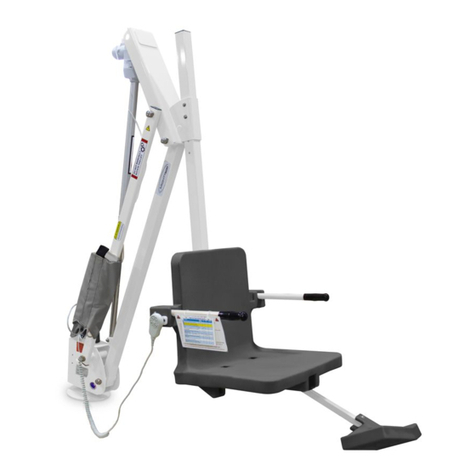
Aqua Creek Products
Aqua Creek Products Mighty 400 manual

Nova Technology International, LLC
Nova Technology International, LLC NAS Series Owner & user manual
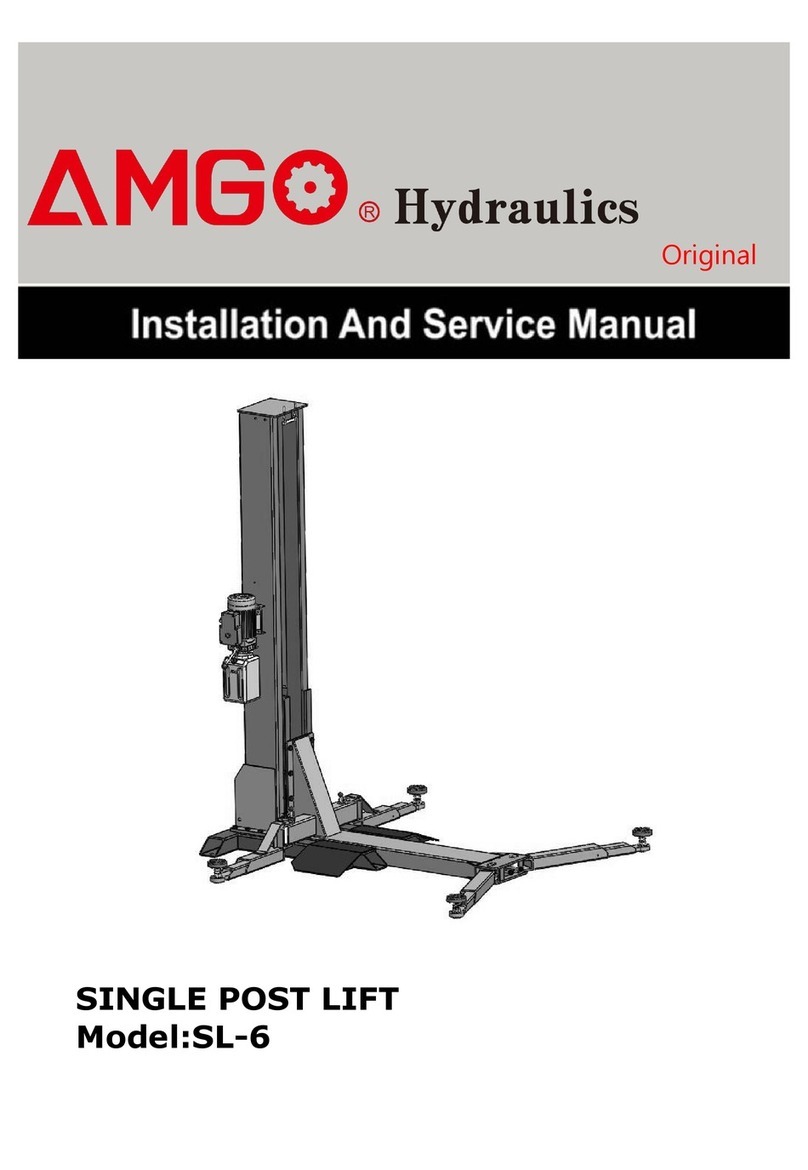
AMGO
AMGO SL-6 Installation and service manual
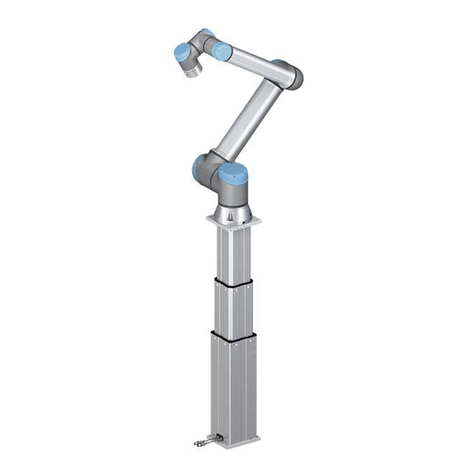
Ewellix
Ewellix LIFTKIT-UR Installation, operation and maintenance manual
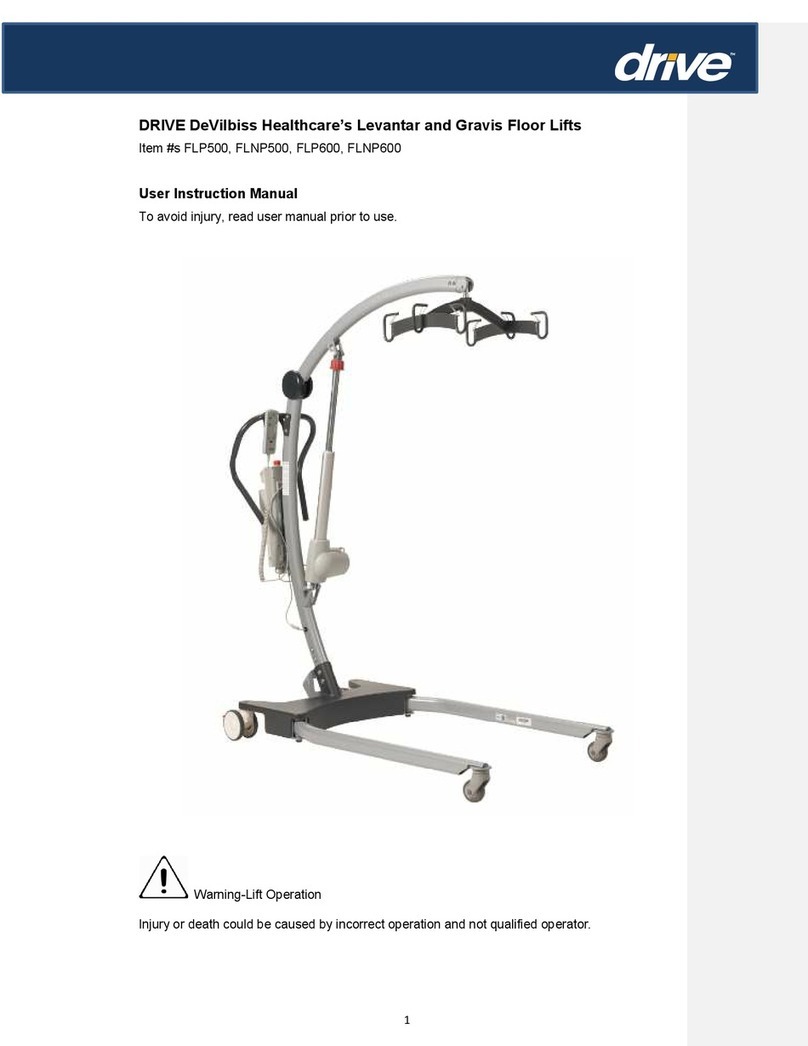
Drive
Drive DeVilbiss Healthcare Gravis FLP500 User instruction manual
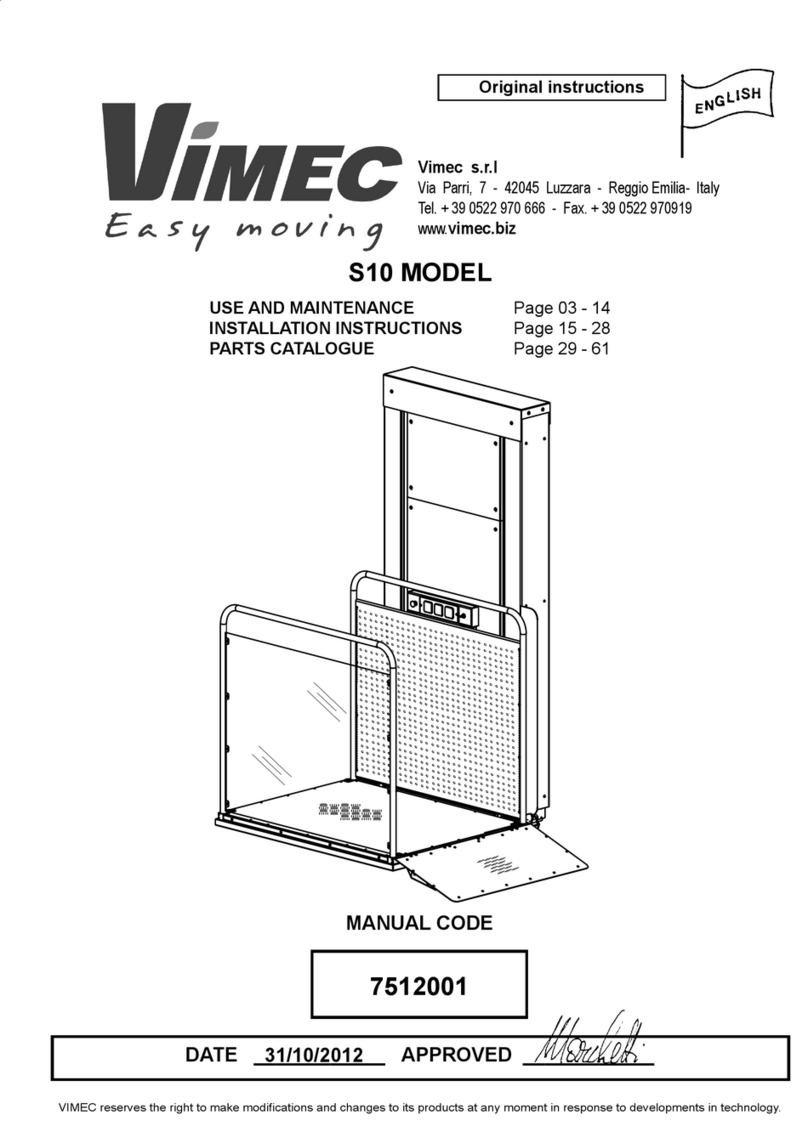
vimec
vimec S10 Original instructions
